Calathea White Fusion Care guide and plant profile. This brightly colored tropical plant creates a stunning lush focal point wherever it sits in your home.
Like all Calatheas, the White Fusion Calathea is a bit of a Diva. Maybe even more than some of the others since its variegated foliage is more sensitive to its light requirements.
This is a plant that requires a little passionate loving. Like the Calathea ornatas and the lovely Zebrina the white fusion is not a beginners plant. Unless you are very interested in plant nurturing. Calatheas will teach you a lot about plant care in a hurry.
I refer you to the Pothos N Joy or the Manjula Pothos for easy care plants with gorgeous variegated foliage that won’t ask much of you.
However, that extra flash of white fused into the green and pink leaf colors of the White fusion…Wow. I think it’s worth a bit of extra nurturing to keep this beauty happy.
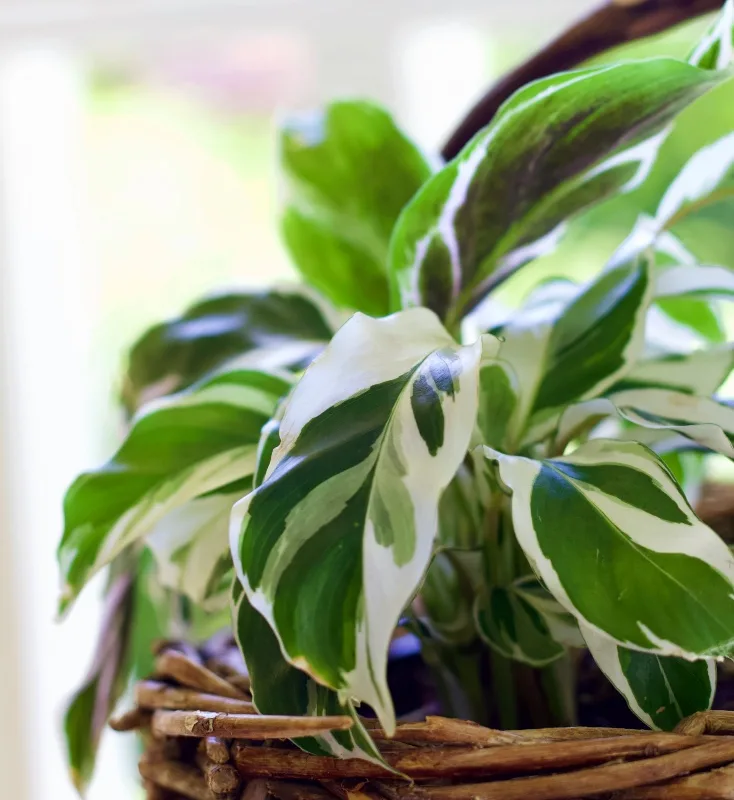
Calathea care is not all that difficult. But the fusion, like all calatheas will suffer if you don’t give it what it requires.

This is my brand new white fusion. I am SO excited about it. I bought my adorable 4 inch white fusion baby on Etsy from Groovy Plants.
Look how gorgeous it is. It arrived well packaged, in great shape and ahead of scheduled arrival. Thanks Groovy plants!
All the pictures in this post are of my Calathea white fusion plant or from their shop. Just so you know….
Purchase Calathea White Fusion on Etsy

Calathea White Fusion Care Guide:
These plants are sensitive to the type of water you use, the specific light requirements and most especially the amount of humidity and watering they need to perform at their best for you.
For best results I recommend you use a plant moisture meter and a hygrometer to keep track of the moisture in the soil and surrounding air.
And be SURE to use distilled water or collect rain water for these tropical plants. Tap water will often burn them and cause the leaves to discolor, curl up and die.
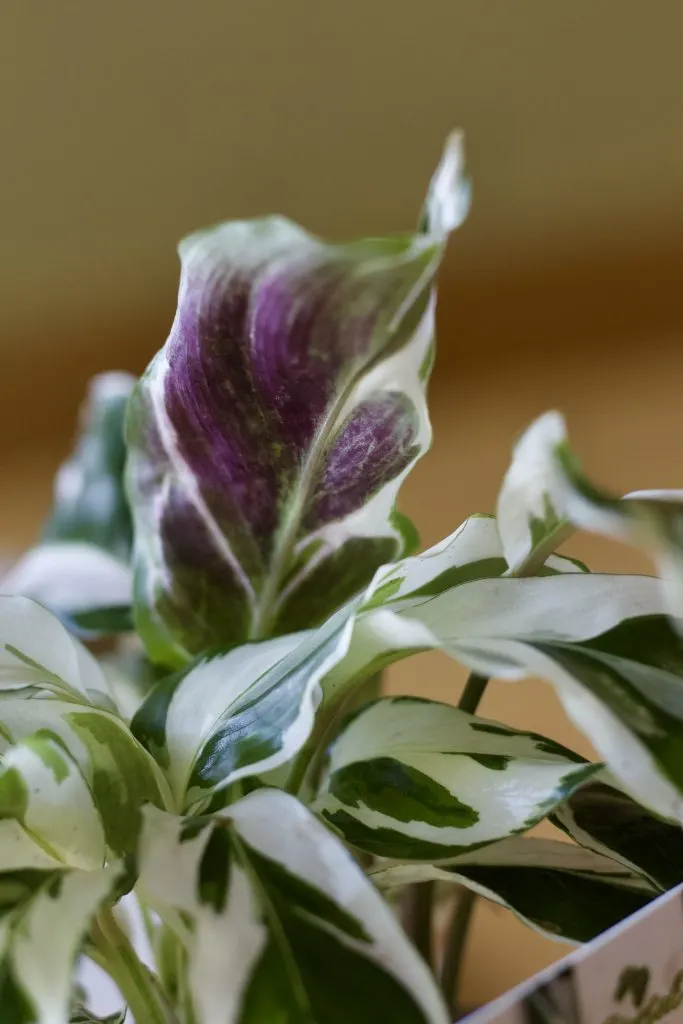
Notice the flash of purple on the undersides of the leaves. This is a signature of all the calatheas I’ve seen. The undersides of the leaves usually have some pink or purple highlights.
My collection of Calatheas are much happier since I began using distilled water with the moisture meter and hygrometer.
If you have a leaf or two that discolor or show brown edges and start to curl up, just snip them off. A healthy fusion will grow new leaves all during the growing season to replace old ones.
Light Pruning will keep your fusion foliage looking fresh and lovely.
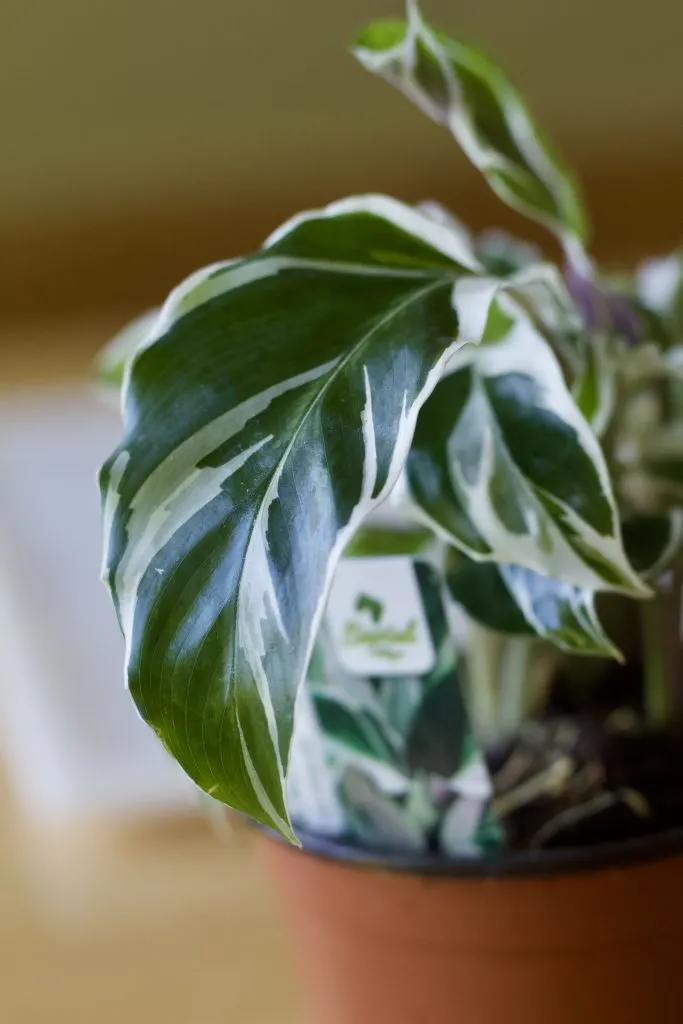
Here’s a very detailed and specific guide to the care of your white fusion calathea Calathea lietzei and some links to useful tools and materials they need to help you with their care.
Since It is a variegated plant you need to keep the light brighter than other Calatheas require or the foliage will fade.
Like all Calatheas, the White fusion is an air filtering plant and its also Non Toxic. More good reasons to Love a Calathea. 🙂
Calathea White Fusion Care guide

Calathea White Fusion is a beautiful, exotic plant. Their care needs are specific and important. They are sensitive. This is Not a forgiving plant.
Once you find the perfect growing conditions for your white fusion calathea it will perform well for you.
Learn what they need and give it to them. Their lovely foliage is so worth the effort!
All Calathea plant care is similar. No matter what type you own this care guide will apply.
Materials
Tools
Instructions
Soil Preference:
- Calatheas enjoy a light well draining soil.
- A mix of potting soil and perlite and peat. Coir will keep the roots happy if well mixed with lighter soils.
- Our mix for this plant is 30 % potting mix, 30% succulent soil or coir and 30% perlite or pumas.
- A heavy soil potting mix is not recommended for these plants.
Pot Size and Type
- Calatheas grow from rhizomes. And they grow new offshoots to the sides of the mother plant.
- This means they will fill a pot out as a wider plant eventually. Quite a nice table top centerpiece.
- Calathea rattlesnake will grow to the size of the pot with one or more rhizomes. If you leave it to grow as a grouping of rhizomes in one pot you will need to find a pot that has a wider circumference. They do not like to be overly root bound.
- If you want to encourage faster growth choose a pot about 2 inches wider in diameter than the current pot.
- Use a well drained ceramic or plastic pot. It MUST have excellent drainage.
- Terra cotta pots are not recommended. They will wick too much water away from the soil.
- Repot every second year or when roots come out the drainage holes on the pot bottom To the next pot size up.
- Don't jump to a huge pot from a small one unless you wish to encourage faster growth. Just go to the next size up pot. A Too large pot with too much constantly moist soil will encourage root rot.
- For Calatheas a self watering pot system work well. (linked above). They control the watering for you and help avoid root rot, overwatering and under watering.
Lighting:
- Calatheas enjoys indirect light for best leaf variegation and optimal growth.
- If the leaves fade move the plant to a less bright area and see if that helps.
- Too much light can also fade the leaves and crisp the leaf edge.
- It will tolerate lower indirect light but the plant may grow more slowly. Leaf variegations may not be well expressed.
- Shield the plant from strong direct light in summer south and west sunny windows. The leaves will burn and the colors will fade. Look for dry brown spots on the leaves and curling brown edges. If you see them move the plant to lower light.
- Tip: Window sheers or blinds can offset some brief periods of high direct light.
Watering:
- Your Calathea is VERY sensitive to the water you use. These plants love low mineral, soft acid water between 5.5 and 6 Ph. Hard water high in minerals and salts will burn the leaves.
- Collect rain water or use Filtered or distilled water to prevent problems with minerals and PH.
- Water your Calathea when the soil is dry down an inch or so. Calatheas enjoy even moisture in the soil. But never let it sit in soaking wet potting mix.
- Be sure to use your moisture meter every couple of days and especially before watering. The dial should read moist when pushed down to the bottom of the root system. If the meter reads dry you need to water. But if it reads wet WAIT. This is important. Calatheas are sensitive to root rot. Do not overwater!
- Calatheas enjoy evenly moist soil. However, don't water your rattlesnake plant until your moisture meter tells you the plant is verging on dry in several places in the soil.
Watering Problems:
- If your calathea leaves start to roll up and curl, the plant droops or the edges turn brown suspect watering problems.
- Under watering can show all the symptoms listed above and most often causes leaf edges rolling up, brown tips and crisping. Adjust your watering or soil mix to accommodate.
- Over watering will end in root rot, grey mold on the leaves, algae growth on the soil and fungus gnats or other pests moving in. Yellowing leaves can also mean the plant roots are too saturated and are starting to die.
- For best practices Try a watering schedule of once a week. But do not water if the soil is wet. Alternately, Do not let the soil dry out completely.
- Watering is best done on a regular schedule with a moisture meter check so the plant is not over or under watered. Both can cause stress.
- These tropical plants enjoy humidity of 50 to 70%. Use a hygrometer next to your calathea to make sure you have enough humidity for them.
- Never let this plant get wet feet. If the soil is compacted the bottom of the soil can remain wet which encourages, grey mold on the leaves, root rot and Fungus Gnats. If you see yellow leaves or leaf tips you are probably overwatering or Inconsistently watering.
- In dormant winter months reduce watering to when the soil is dry down 2 inches .
Humidity Tips:
- Calatheas are happy at 50 to 60% humidity. Although they can tolerate higher, do not let it drop under 40%.
- I use an inexpensive hygrometer to monitor the room temperature and humidity levels near mine. It is cheap and so helpful!
- In dry climates this plant will thrive with a humidifier nearby. Or set it in your kitchen or bathroom.
- Frequent misting on a regular daily schedule will help keep humidity up when all else fails. However, misted leaves can be hosting spots for bacteria and fungi.
- Set the Calathea plant on a pebble tray with water not touching the pot bottom for added humidity as necessary.
- Grouping plants together will also provide more humid conditions as they respire and evaporate.
How to Fertilize:
- Calatheas require a regular fertilizing schedule. BUT, they are susceptible to fertilizer burn.
- Apply a good quality fertilizer (linked in materials) monthly through Spring and summer at half dose. If you see burn marks on the plant leaves reduce fertilizer by half again.
- Decrease feedings by late Fall and allow your Calathea plant to rest through the winter months.
- Look for brown spots on the leaves of your plants. This may indicate an over concentration of salts in the roots from over feeding. It can burn the leaves.
- The remedy is to set the plant under a faucet of water and let the water run through for 10 minutes or so. Allow the pot to Completely drain. Discontinue fertilizer until the plant recovers.
Temperature:
- Optimal temperatures for White Fusion Calathea plants are 65 degrees F. to 75 degrees F.
- Calatheas are sensitive to cold drafts from windows and doors.
- In winter, beware heat vents blowing on your plant leaves. Calatheas cannot tolerate uneven heating, or drying heat vents or drafts.
Pruning and Training:
- Sharp sterile Hand pruners or sharp scissors are preferred for pruning. They will give a clean cut that will heal quickly.
- Pruning is usually done to shape the plant or cut off unsightly leaves.
- Calatheas grow wider rather than taller with time. The White fusion plant grows to about 15 inches high. This makes them good choices for desk and table top plants. Or set them in a deep, indirectly lit window sill.
Leaf Care: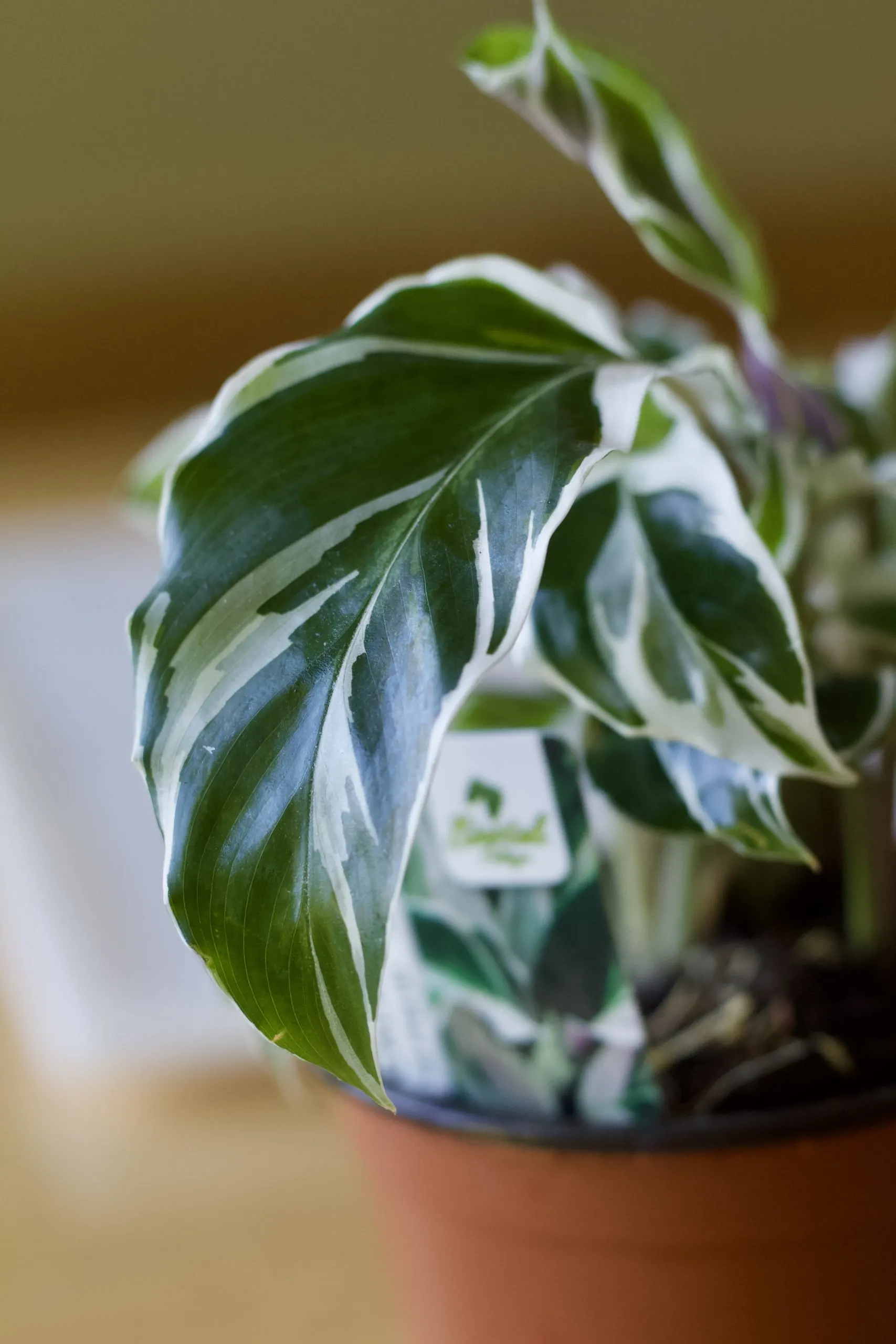
- For the best care your Calathea leaves enjoy occasional washing.
- This helps keep the stomata (leaf pores) open for plant respiration.
- Healthy leaves with a good clean surface are most able to resist pests. Neem oil leaf shine and water is a good choice for leaf washing.
- Dusty leaves will starve the plants of water exchange through humidity.
- washing your plant leaves is also a great way to keep pests off the leaves. And early pest intervention since you are closely examining your plant.
- Hand Wash the leaves monthly with water and neem oil.
- You can also use a shower to clean off a calathea. Beware the water temperature. Keep it room temperature to avoid shocking the plant.
Pests:
- All plants get attacked by pests. Calatheas are especially susceptible to spider mites.
- Stress by longterm poor watering practices, poor light, extreme temperatures and soil conditions are contributors to pests. Fungus gnats will set up house in the soggy soil of an overwatered plant.
- Washing the plant leaves occasionally with neem oil leaf shine will help keep pests from establishing themselves on the plant.
- Spider mites are the biggest problem for Calathea plants. Watch for the webs. Treat immediately and continue for two weeks or more to remove the next generation of spider mites after the adults die. Eggs attach to the leaves and cannot be washed off easily.
- Mealy bugs, scale, thrips and whitefly are also common houseplant pests you will see in a stressed Calathea.
- Read our post on How to get rid of aphids and other pests with our homemade pesticide soap recipe or neems oil.
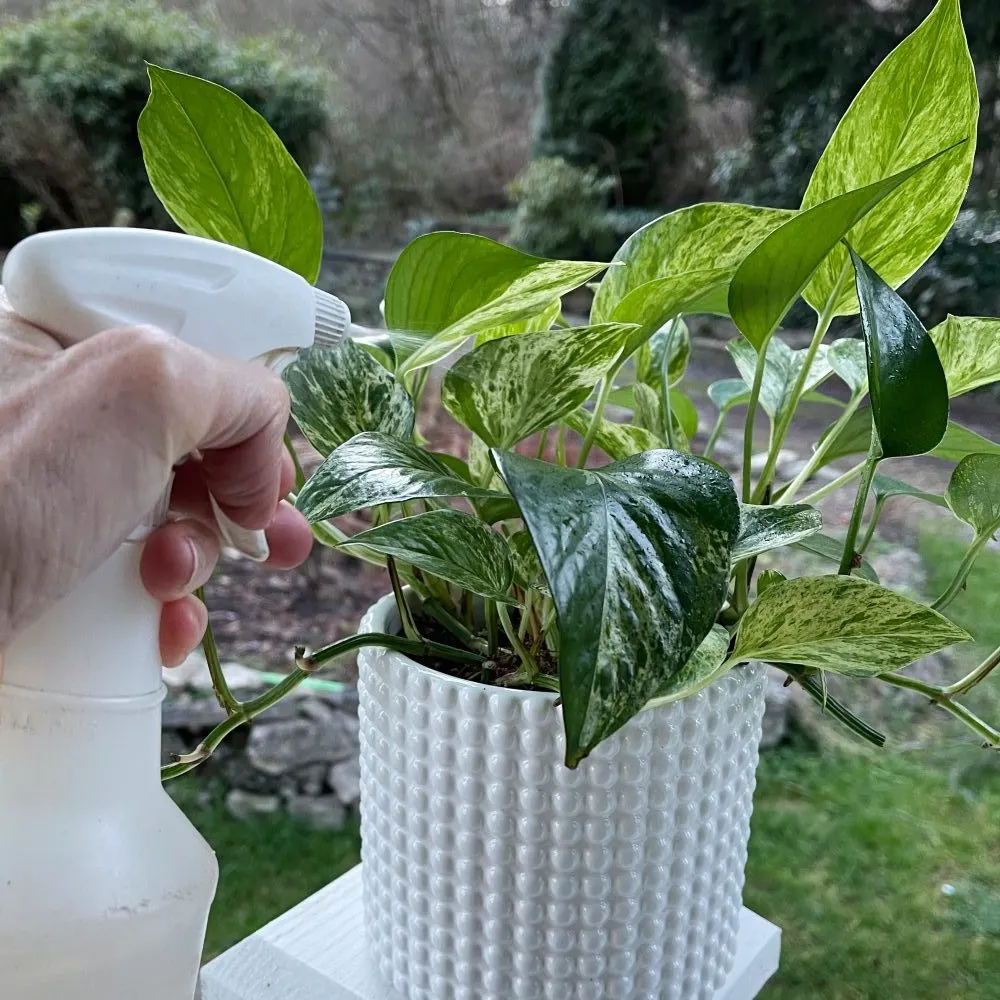
- To minimize the possibility of pests be sure to check all nursery plants before bringing them home. Carefully examine the top and bottom of the leaves.
- Do NOT purchase plants with signs of pest damage or disease.
- Quarantine all new plants until you are sure no pests live in them.
How to Propagate Calatheas:
- Propagation is best done through root division.
- Seed propagation can be done but the seeds can be difficult to source.
- Dividing a calathea is easiest when repotting it in spring or summer.
- Unpot the plant gently. Look at the root system. If the plant is mature you should see a natural parting in the leaves and roots. This is the two plants growing together.
- Each plant section will have its own rhizome. This is going to look like the stem growing straight down with roots coming off them.
- Gently pull apart the two rhizomes to separate them. If the roots are heavily intertwined cut them as necessary with sharp sterile scissors or small pruners.
Pot the two plant sections in separate pots. In 2 to 4 weeks the divisions should be settled and growing.
Non Toxic Plant:
- All calatheas are non toxic to humans and pets. Still it is not recommended to chew any houseplant.
- Biting or swatting are not good for the health of the plant.
- Also you don't know what chemicals, pests or pathogens are in the soil or fertilizers you use. So best practice is to keep houseplants away from pets and kids.
Notes
The video below is relevant to the care of all calatheas:
Follow Us:
Find us on YouTube, Instagram , Pinterest and TikTok! We love to Plant chat. We also comment, like and occasionally share your content to our daily stories. We’d love to see your plants. Share your joy in your houseplants. Happy Planting!
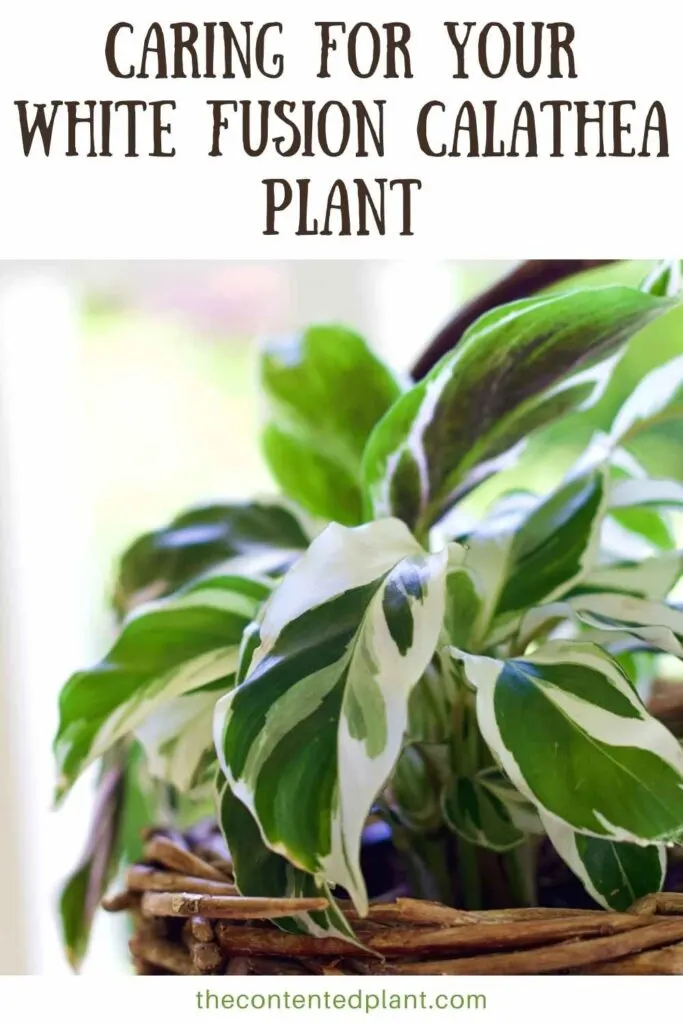

Philodendron White Knight - The Contented Plant
Sunday 23rd of April 2023
[…] Calathea White fusion Care Guide and Plant Profile […]
Stromanthe Triostar Care and Plant Profile - The Contented Plant
Thursday 25th of August 2022
[…] triostar plants have Tri color foliage quite similar to the cultivar Calathea White […]
Mold On Plant Soil-Is it harmful? How to Kill It - The Contented Plant
Sunday 6th of March 2022
[…] Calathea White fusion Care Guide and Plant Profile […]